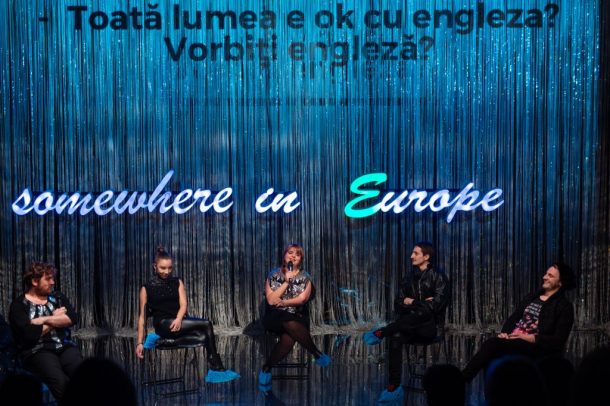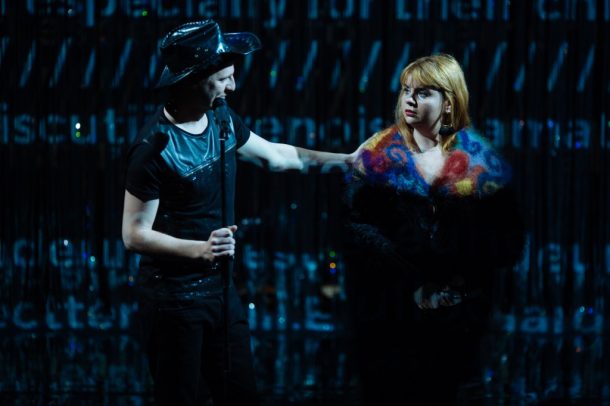“The role of the artist is to ask questions, not answer them.” One of the most quoted Chekhovian statements seems to contradict the habit of organizers to include in cultural events’ programs frequent famous discussions between artists and spectators (the latter being either- journalists or critics). The mission of the Q&A sessions is, in theory at least, to build a bridge between the creative team and the target public, sometimes providing “that missing link” in their relationship. In practice, these may reveal the artists’ intentions and thoughts (otherwise unknown) or, on the contrary, these may develop into an alternation of diluted truisms and neologisms – big talk versus small talk. One can usually find the commonly recurring “artistic approach”, “collaborative projects”, “artistic concept”, “challenge”, “artistic message”, “transparency”, “social/political art”, “empathy”, “performing arts”, “syncretism”, “eclecticism”, “interesting”, “captivating”, “wonderful”, “splendid” and numerous such phrases and words… Big words versus small words. All sort of words.
Artists Talk is the title of the latest production by the Romanian playwright-director Gianina Cărbunariu. It was co-produced at the beginning of 2017 by the Bucharest Cultural Center (ARCUB) together with the Association Piese Refractare. “In the last two years we have witnessed interesting situations, where the social and political contexts have strongly impacted the way artistic discourse was delivered and received. Given the situation, an artist experiences a certain responsibility. Since we are living in a world that is less and less inclined towards dialogue, what are now the artistic tools to operate with?” This is the question Gianina Cărbunariu (b. 1977) is asking herself. She is one of the most important personalities of present-day Romanian theatre – an all-round creator, author and director of the scripts that are the basis of her shows, staged in this country and abroad. These approach contemporary topics or are inspired by recent history, whereby the documentation process (through interviews and archival research) is followed by improvisations performed by actors (selected from her age group or younger). This results in fictional scripts, in which real elements (excerpts from interviews, pictures, and objects) are integrated. Many of these have been translated and staged by other directors, and the shows have won high recognition by the theatrical world. In 2014, Solitaritate, a production of the Radu Stanca National Theatre of Sibiu, was included in the official selection of the Festival d’Avignon, and in 2016, Gianina Cărbunariu was once again invited by the Festival, as the playwright of Tigern, which was produced by the Swedish Jupither Josephsson Theatre Company. In 2017, she has been the artist selected to represent Romania at the Festival de Liège, with her production Artists Talk.
A critical spirit with her mind always troubled by questions, Gianina Cărbunariu could have been a quintessential “Angry Young Man” during the last century. Nowadays, she embraces the mission of re-shaping Romanian theatre by focusing on local, contemporary creations, and rejecting any expression of formal and ideological conservatism. However, just like Chekhov, she affirms that the role of the artist is to ask questions. As far as the question of providing the answer is concerned, this role might be taken up by the viewers who are involved in the production and possibly, in solving the problems raised by it. This is exactly the case with Artists Talk which, inspired by discussions with spectators and documented interviews, asks questions. “As a part of this system, we were interested to understand how the artist’s responsibility (or the absence of it) reveals itself from the discourse about his approach, and about the world he lives in,” the playwright confesses.

A Scene from Gianina Cărbunariu’s Artists Talk featuring Ilinca Manolache and Bogdan Zamfir. Photo Courtesy: Adi Bulboacă.
In five scenes and a prologue that sets the show’s protocol, artists from every field are (self-)incited to participate in a discussion. The general action takes place “somewhere in Europe,” even though the stories take us to TV shows, theatre and film festivals, and public venues, identifiable or not. The set and costumes are designed by the German set designer Dorothee Curio, who is working for the second time with Gianina Cărbunariu, after Sold Out, a production of the Münchner Kammerspiele in 2010. The small stage of the ARCUB hall is horizontally outlined by a shiny floor where the actors walk wearing shoe covers (as in museums or hospitals), and vertically by a background of glittering fringes (as in a cabaret stage or a music hall). The predominantly black costumes are adorned with colored or sparkling decorations by means of which every artist boosts their personality. (In-between the episodes, the actors change clothes almost in full view within one of the stage wings). The whole set design belies a “casual glamour” edge, including the videos conceived by visual artist Mihai Păcurar. The atmosphere is supplemented with audio contributions by composer Bobo Burlăcianu, by means of his electro dance music which is rhythmic, abrupt, and, due to its varied characteristics, ironically pointing towards different stories.

A Scene from Gianina Cărbunariu’s Artists Talk featuring Gabriel Răuţă, Ilinca Manolache, Ruxandra Maniu, Bogdan Zamfir, and Alexandru Potocean, 2017. Photo Courtesy: Adi Bulboacă.
“Irony” and “self-irony” are, in fact, the words that best describe this show. Sometimes accused of obvious theses in her productions dedicated to social issues, Gianina Cărbunariu seems to have gotten even this time through the humor of the production found both in its extremely hilarious text and in the performance of the Romanian actors, which, perhaps, reveals how they are all too familiar with the debated “artistic system,” regardless of their personal affinity to it. Ruxandra Maniu, Ilinca Manolache, Alexandru Potocean, Gabriel Răuţă are all either older or more recent collaborators with the director; they are renowned actors who play both at state theatres and in independent productions. They are joined by Bogdan Zamfir in his first appearance on the Romanian stage. Formally trained in Belgium, he is presently working with the French playwright-director Joël Pommerat.
And the “artists talk” in their own language – the artistic one – no matter if it is Romanian, English, French or even a little bit of Czech. The “artists talk” sometimes the language of sincerity, at other times that of a sacred ignorant naivety, and most of the times, that of hypocrisy. The rhetorically claimed honesty keeps hidden other interests and flaws such as vanity, indifference, or artistic self-conceit. These are revealed in answers to the endlessly (and stupidly) repeated questions of the media people, such as, “What was the author’s intended meaning?”, “What was the creative drive?”, “What are your future plans?”, etc. Sometimes, the developing discussions are sterile, sometimes, they are thrilling. Although the resemblance to real persons is not coincidental, the identification of a certain artist having a specific rhetoric is not what’s at stake in this fiction. The particular becomes the universal – even if this “particular” gets to be “represented” by a Romanian mayor, who built a wall (or, a fence) between two ethnic city communities, inviting afterwards a group of visual arts students to paint and turn it into a work of street art, and even if this “particular” can have the name of the Latvian director Alvis Hermanis, who refused to work in a theatre because of it being a “Refugees-Welcome-Center”, and even if, in the last scene of the show, this “particular” actually ends up bearing the name of Irène Némirovsky, a novelist of Ukrainian Jewish origin. Born in the Russian Empire, Némirovsky lived more than half her life in France and wrote in French, but was denied French citizenship. Arrested as a Jew under racial laws, she died at Auschwitz at the age of 39, and became famous posthumously by means of modern marketing.

A Scene from Gianina Cărbunariu’s Artists Talk featuring Ruxandra Maniu and Alexandru Potocean. Photo Courtesy: Adi Bulboacă.
Questions abound about anti-Semitism, about the individual destiny facing the collective one, about responsibility and the artist’s freedom, about the reception of a work of art… There are more questions about the world’s refugees, or about those who are refugees in their own country, about country borders, about walls between us and the rest of the world… Then, there are questions about “art for art’s sake” versus “art with a message”… What does “mainstream” mean today? What does it mean to be “fashionable”? Is it better to remain “a fly on the wall”, or must you commit to a cause as an artist? These are all questions which Gianina Cărbunariu does not offer to answer, nor does she intend to pronounce verdicts – she only presents the issues. Excellently balanced, delivered with much humor and (self-)irony, the answers reach their target. Due to the range of problems tackled and its exemplary acting, ARCUB’s Artists Talk is a production that meets European standards. It reveals a Europe that is redefining not only its borders but also its artistic tools – a Europe that is seeking to find itself…
Maria Zărnescu (b. 1969, Bucharest) is a Romanian theatrologist and critic, and an Associate Professor at the National University of Theatrical Arts and Cinematography in Bucharest. She is the author of books Music and Muses (2015) and The Sound of Theatre Music (2016). She has also written numerous theatrical and music reviews, and has had her studies and essays published in Romanian and international journals. She received the Romanian Association of Theatre Professionals UNITER Award for Best Theatre Critic in 2015. She has extensive consolidated experience as a radio journalist and manager, a TV editor, and an event producer.
European Stages, vol. 9, no. 1 (Spring 2017)
Editorial Board:
Marvin Carlson, Senior Editor, Founder
Krystyna Illakowicz, Co-Editor
Dominika Laster, Co-Editor
Kalina Stefanova, Co-Editor
Editorial Staff:
Cory Tamler, Managing Editor
Mayurakshi Sen, Editorial Assistant
Advisory Board:
Joshua Abrams
Christopher Balme
Maria Delgado
Allen Kuharsky
Bryce Lease
Jennifer Parker-Starbuck
Magda Romańska
Laurence Senelick
Daniele Vianello
Phyllis Zatlin
Table of Contents:
- Festival Transamériques, 2016: The Importance of Saying No by Philippa Wehle
- Ukrainian Contemporary Theatre as Cultural Renewal: Interview with Volodymyr Kuchynskyi, March 2015 by Seth Baumrin
- A Month in Berlin: Theatre for All Ages by Beate Hein Bennett
- New Productions and Revivals in Berlin by Yvonne Shafer
- An Experiment of Strangeness: The 2016 Interferences International Theatre Festival in Cluj by Eylem Ejder
- A (Self-)Ironic Portrait of the Artist as a Present-Day Man: The Newest Trademark Show of Gianina Cărbunariu in Bucharest by Maria Zărnescu
- Do You Speak Silence?, asks Gianina Cărbunariu in Sibiu, Romania by Ion M. Tomuș
- Une chambre en Inde (“A Bedroom in India”): A Collective Creation by the Théâtre du Soleil and Ariane Mnouchkine by Marvin Carlson
- Only When in Rome?: Albert Camus’ Caligula at the Theater Basel by Katrin Hilbe
- Terrassa’s TNT Festival: The New, the Usual and the Ugly by Maria M. Delgado
- Puzzling Perspectives On Ever-Shifting Conflict Zones by Talya Kingston
- Sister Act(s): Catholic Schoolgirls Rule by Duncan Wheeler
- Re-framing the Classics: La Cubana Reinvent Rusiñol and the Lliure Revisit Beaumarchais by Maria M. Delgado
- John Milton’s Comus: A Masque Presented at Ludlow Castle: Shakespeare’s Globe, London by Neil Forsyth
- Musical in Bulgaria: A Mission Possible by Gergana Traykova
- What Happens to Heroes: Heinrich von Kleist’s Prinz Friedrich von Homburg at Schauspiel Frankfurt by Katrin Hilbe
- Krystian Lupa and Thomas Bernard in Paris, Fall, 2016 by Manuel García Martinez
Martin E. Segal Theatre Center:
Frank Hentschker, Executive Director
Marvin Carlson, Director of Publications
Rebecca Sheahan, Managing Director
©2016 by Martin E. Segal Theatre Center
The Graduate Center CUNY Graduate Center
365 Fifth Avenue
New York NY 10016



